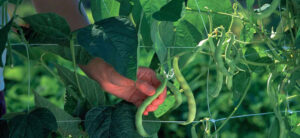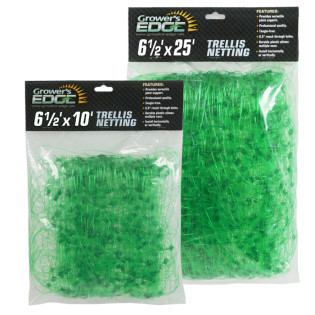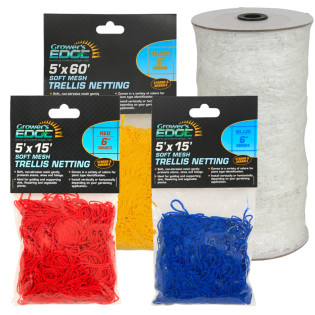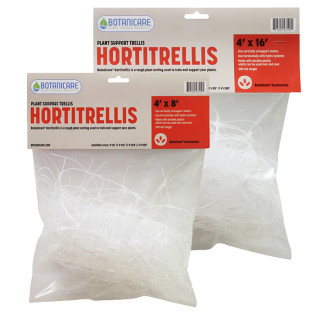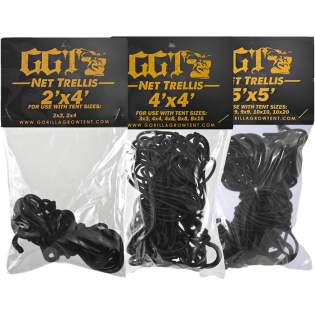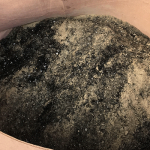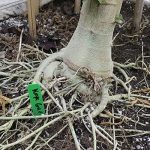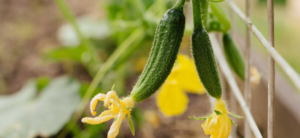
The one aspect of indoor and outdoor gardening that isn’t discussed enough is trellis netting and other types of plant support.
Every grower is going to need to use them at some point, but understanding different methods can be confusing.
There are, after all, dozens of products to choose from.
How do you know what is right for your needs?
That really depends on the type of plant and what you’re planning to do with the plant. We will discuss a few common trellis strategies below.
Why should you use trellis netting?
Trellis netting is great for training the direction you want your plants to grow.
It also helps support the plant, and the weight of the large buds you hope to cultivate.
The two main methods of trellising are vertical and horizontal.
This refers to whether you are directing the plant to grow very tall, or if you want short, wide plants.
By using trellis in your garden, you can make the most out of your growing space. If you have limited height, you can implement a horizontal trellis system to push a wide canopy.
As you begin flowering, your stems will become stressed from the added weight, and the last thing you want is for one to snap. Trellis netting will prevent this from happening.
Training your plants with SOG and SCROG
There are two very prominent trellis strategies, known as SOG and SCROG.
SOG, or sea of green, is a strategy where growers try to maximize the space they have by fitting as many plants as possible. Plants are harvested very quickly, and tend to yield lower.
SCROG, or screen of green, is the opposite mindset. Here, growers try to optimize the space they have with fewer plants.
Plants are trained to grow as wide as possible, with as many branches to produce buds as possible.
Plants are given ample veg and flowering times, and the trellis is very necessary for holding the heavy buds.
Other common uses for trellis netting
Other than training your plants direction of growth, there are a number of other uses for garden trellis.
Vining crops perform well with trellis netting.
Trellis netting is made with vining crops in mind. It comes in a variety of sizes and weaves depending on the intended use. It also comes in common sizes of 4’ X 8’, 4’ X 16’ and 4’ X 100 which is a generous size for covering an entire greenhouse.
Trellis netting is best for vining crops because the nature of the plant doesn’t lend itself to other forms of support such as central pole. The web netting provides ample space within the web for easy access to the fruit, but is strong enough to bare the weight of the entire plant.
Go with the commercial grade, however, because vining crops are heavy, and this grade can fully support that weight without sagging or falling.
Bamboo stakes are handy for floral plants & tomatoes.
Bamboo stakes have multiple uses and are best for any single central stemmed plant like a tomato.
They can be run tight against the stem which is where this type of plant needs the support to prevent sagging and breaking.
They are also the preferred method for plants headed for retail sale like houseplants or blooming plants such as kalanchoe.
Bamboo stakes work great when secured with the 8” plastic cable ties, although, do not secure them so tightly that they tear into the plant’s stem flesh.
Plant yo-yos also work excellent on stationary central stemmed plants like tomatoes and related plants.
They’re slick devices that suspend from the ceiling and pull out just as the name implies.
Plant pull ties work well on stationary plants without restricting fruit access or getting in your way.
Plant ties come in easy to work with lengths of 50’, 100’ and 250’ and are another way to anchor those tough vining plants without the hassle of netting tangling you up.
However, you can not rely on a single strand stretched across the growing area.
Cucumbers, melons, or squash plants vine at multiple points. So, when using plant ties, you need to stretch several at various intervals in height.
You will do best by layering the plant tie at one-foot intervals.
Grid supports are excellent support and marketing tools for retail vining blooming plants.
Grid supports are often overlooked but are excellent for anchoring and displaying retail blooming plants like climbing rose or clematis.
A grid support is a round gridded metal ring with a central support pole.
Using a grid support, multiple vining stems of a rose or clematis can be and anchored with twist ties separately to the grid, maximizing the bloom features of the plant.
This safely secures the vining stems of the plant while also fully enticing the customer with its colorful blooms.
Other plant training concerns
While using trellis netting is a great start to becoming a more advanced grower, there are other training tactics you should employ. The most important is pruning.
Pruning your plants allows you to further dictate the manner in which your plants grow.
Topping your plants
You will often find that one dominant shoot will outperform other branches on your plant. In this case, you should "top" the shoot. This is where you cut that shoot down to the same level as the other branches.
This will shock the plant, but the end result will be energy spent on the rest of the plant, instead of the dominant shoot taking all the growth. The result of this is a more even canopy, and more budding sites throughout the plant.
Pruning your plants
Topping is important, but you should be periodically pruning other areas of your plant as well. However, you don't want to go crazy and start chopping off leaves and branches willy nilly.
You should remove a portion of large fan leaves, to encourage growth of stems and bud sites. You don't want to remove too many fan leaves, as this will also stress the plant, but removing some will supercharge growth.
Prune growth on the bottom of the plant that receives no light. This will encourage growth on the areas of the plant that are actually exposed to grow lights.
Final Thoughts On How To Use Trellis Netting As Plant Support
Now that you have a better idea on how to use trellis netting in various ways, you can pick how you want to train your plants and boost your yields.





